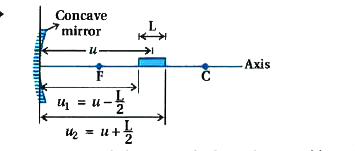For a glass prism (μ=√3) , the angle of minimum deviation is equal to the angle of the prism . Find the angle of the prism . Solution in Gujrati
Refractive index of material of prism.
μ=sin(A+Dm2)sin(A2)
but Dm=A
∴μ=sinAsinA2
=2sinA2cosA2sinA2[∵sinθ=2sinθ2cosθ2]
∴√3=2cosA2
∴cosA2=√32
∴A2=30∘
∴A=60∘
Topper's Solved these Questions
- BOOK - KUMAR PRAKASHANCHAPTER - RAY OPTICS AND OPTICAL INSTRUMENTSEXERCISE - SECTION-C (NCERT EXEMPLAR SOLUTION) (SHORT ANSWER TYPE QUESITONS)6videos
RAY OPTICS AND OPTICAL INSTRUMENTS
- BOOK - KUMAR PRAKASHANCHAPTER - RAY OPTICS AND OPTICAL INSTRUMENTSEXERCISE - SECTION-C (NCERT EXEMPLAR SOLUTION) (LONG ANSWER TYPE QUESITONS)5videos
RAY OPTICS AND OPTICAL INSTRUMENTS
- BOOK - KUMAR PRAKASHANCHAPTER - RAY OPTICS AND OPTICAL INSTRUMENTSEXERCISE - SECTION-C (NCERT EXEMPLAR SOLUTION) (MULTIPLE CHOICE QUESTIONS (MCQs))16videos
RAY OPTICS AND OPTICAL INSTRUMENTS
- BOOK - KUMAR PRAKASHANCHAPTER - MOVING CHARGES AND MAGNETISMEXERCISE - SECTION D (MCQs ASKED IN COMPETITIVE EXAMS)34videos
MOVING CHARGES AND MAGNETISM
- BOOK - KUMAR PRAKASHANCHAPTER - SAMPLE QUESTION PAPER EXERCISE - PART-B SECTION-C5videos
SAMPLE QUESTION PAPER
Similar Questions
A short object of length L is placed along the principal axis of a concave mirror away from focus. The object distance is u. If the mirror has a focal length f, what will be the length of the image ? You may take L<<|v−f|.
 01:39View Solution
01:39View SolutionShow that for a material with refractive index μ≥√2~ , light incident at any angle shall be guided along a length perpendicular to the incident face.
02:12View SolutionA ray of light incident at an angle θ on a refracting face of a prism emerges from the other face normally. If the angle of the prism is 5∘ and the prism is made of a material of refractive index 1.5, the angle of incidence is
01:23View SolutionElectric charge Q having mass M moves on a circular path of radius R with velocity →v, perpendicular to uniform magnetic field B. When a particle completes one revolution, work done by the field is _______
01:31View SolutionTwo charges –q and +q are located at points (0, 0, –a) and (0, 0, a), respectively.
(a) What is the electrostatic potential at the points (0, 0, z) and (x, y, 0) ?
(b) Obtain the dependence of potential on the distance r of a point from the origin when r/a>>1 .
(c) How much work is done in moving a small test charge from the point (5,0,0) to (–7,0,0) along the x-axis? Does the answer change if the path of the test charge between the same points is not along the x-axis?03:32View SolutionThe angle of minimum deviation for a glass prism with mu=sqrt3 equals the refracting angle of the prism. What is the angle of the prism?
03:02View SolutionThe angle of minimum deviation for a glass prism with mu=sqrt3 equals the refracting angle of the prism. What is the angle of the prism?
02:59View SolutionAngle of minimum deviation is equal to the angle of prism A of an equilateral glass prism. The angle of incidence at which minimum deviation will be obtained is
View SolutionAngle of minimum deviation is equal to the angle prism A of an equilateral glass prism. The angle incidence at which minimum deviation will be obtained is
02:24View SolutionFor a glass (μ=√3) the angle of minimum deviation is equal to the angle of the prism. Find the angle of the prism.
01:58View Solutionn=√3 वाले काँच के प्रिज्म का न्यूनतम विचलन कोण इसके अपवर्तक कोण के बराबर है। प्रिज्म का कोण होगा।
View SolutionFor a glass prism (μ=√3) the angle of minimum deviation is equal to the angle of the prism. Find the angle of the prism.
03:05View SolutionFor a glass prism ( n=sqrt(3) ) the angle of minimum deviation is equal to the angle of the prism. Find the angle of prism.
02:43View SolutionThe angle of minimum deviation for a glass prism with mu=sqrt3 equals the refracting angle of the prism. What is the angle of the prism?
01:12View SolutionThe angle of minimum deviation for a glass prism with μ=√3 equals the refracting angle of the prism. What is the angle of the prism?
02:04View Solution

